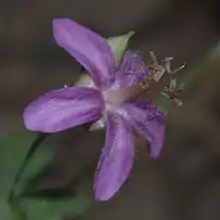| Geranium caespitosum | |
|---|---|
 | |
| Scientific classification | |
| Kingdom: | Plantae |
| Clade: | Tracheophytes |
| Clade: | Angiosperms |
| Clade: | Eudicots |
| Clade: | Rosids |
| Order: | Geraniales |
| Family: | Geraniaceae |
| Genus: | Geranium |
| Species: | G. caespitosum |
| Binomial name | |
| Geranium caespitosum | |
| Synonyms | |
Geranium caespitosum, the purple cluster geranium or pineywoods geranium, is a perennial herb native to the western United States and northern Mexico. Its US distribution includes Arizona, Colorado, Nevada, New Mexico, Texas, Utah, and Wyoming.[4]
It has a purple to red flower with 5 stamens, and the sepals are acuminate, tapering with a long point. It has palmately lobed leaves. The fruit is a schizocarp made up of 5 mericarps. Flowers bloom May to September.[5] Geranium caespitosum has fleshy roots that penetrate deeply into the soil.[6] It grows in damp soils, as in the understory of coniferous forests and in canyons.
Uses
The Gosiute use the plant as an astringent and a decoction of the root to treat diarrhea. The Keres use roots crushed into a paste to treat sores, and the whole plant as turkey food.[7]
Cultivation
The pineywoods geranium is grown in xeriscape and native plant gardens for their well displayed pink flowers.[6]
Varieties
The four varieties may known by the following common names:
- G. c. var. caespitosum – pineywoods geranium
- G. c. var. eremophilum – purple cluster geranium
- G. c. var. fremontii – Fremont's geranium
- G. c. var. parryi – Parry's geranium
In the United States, all four varieties are found in Arizona and New Mexico, and the purple cluster geranium is only found there. The other varieties are all found in Colorado, Utah, and Wyoming, and the pineywoods variety extends into Nevada and Texas.[4]
Image gallery
 red individual
red individual.jpg.webp) lilac individual
lilac individual foliage
foliage var. fremontii
var. fremontii var. fremontii
var. fremontii
References
- ↑ In: Account of an Expedition from Pittsburgh to the Rocky Mountains. Philadelphia: H.C. Carey and I. Lea 2: 3. 1823. "Plant Name Details for Geranium caespitosum". IPNI. Retrieved July 5, 2010.
[Notes on the type specimen:] Mora River, San Miguel County (New Mexico, South-Central U.S.A, Northern America)
- ↑ "Global Biodiversity". Archived from the original on 2016-03-04. Retrieved 2011-10-01.
- ↑ Catalogue of Life
- 1 2 Geranium caespitosum. PLANTS Profile. USDA. Accessed 23 June 2013.
- ↑ "Lady Bird Johnson Wildflower Center - The University of Texas at Austin". www.wildflower.org. Retrieved 2022-03-02.
- 1 2 Barr, Claude A. (1983). Jewels of the plains : wild flowers of the Great Plains grasslands and hills. Minneapolis: University of Minnesota Press. p. 18. ISBN 0-8166-1127-0.
- ↑ Geranium caespitosum. Native American Ethnobotany. University of Michigan - Dearborn. Accessed 23 June 2013.
